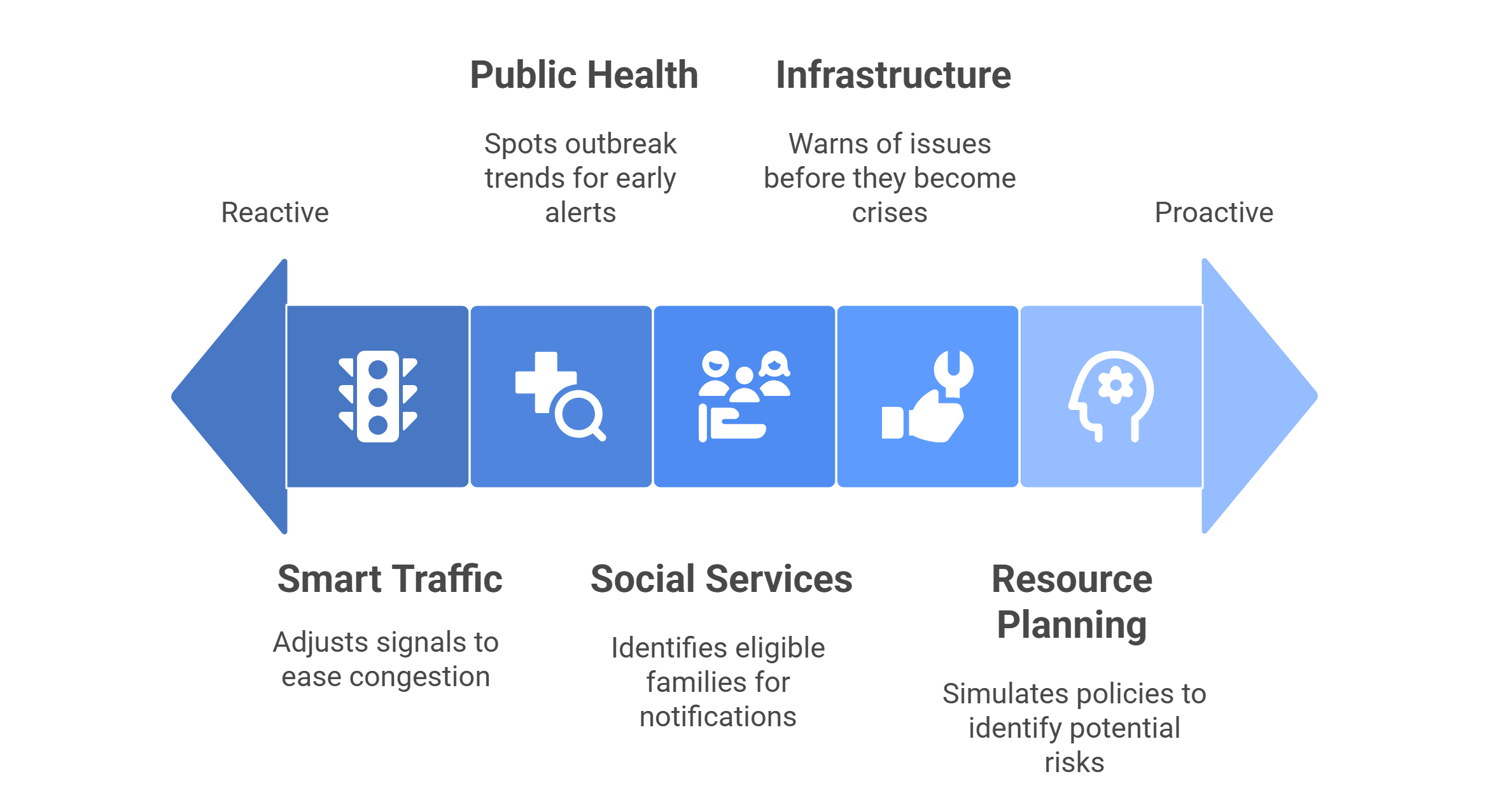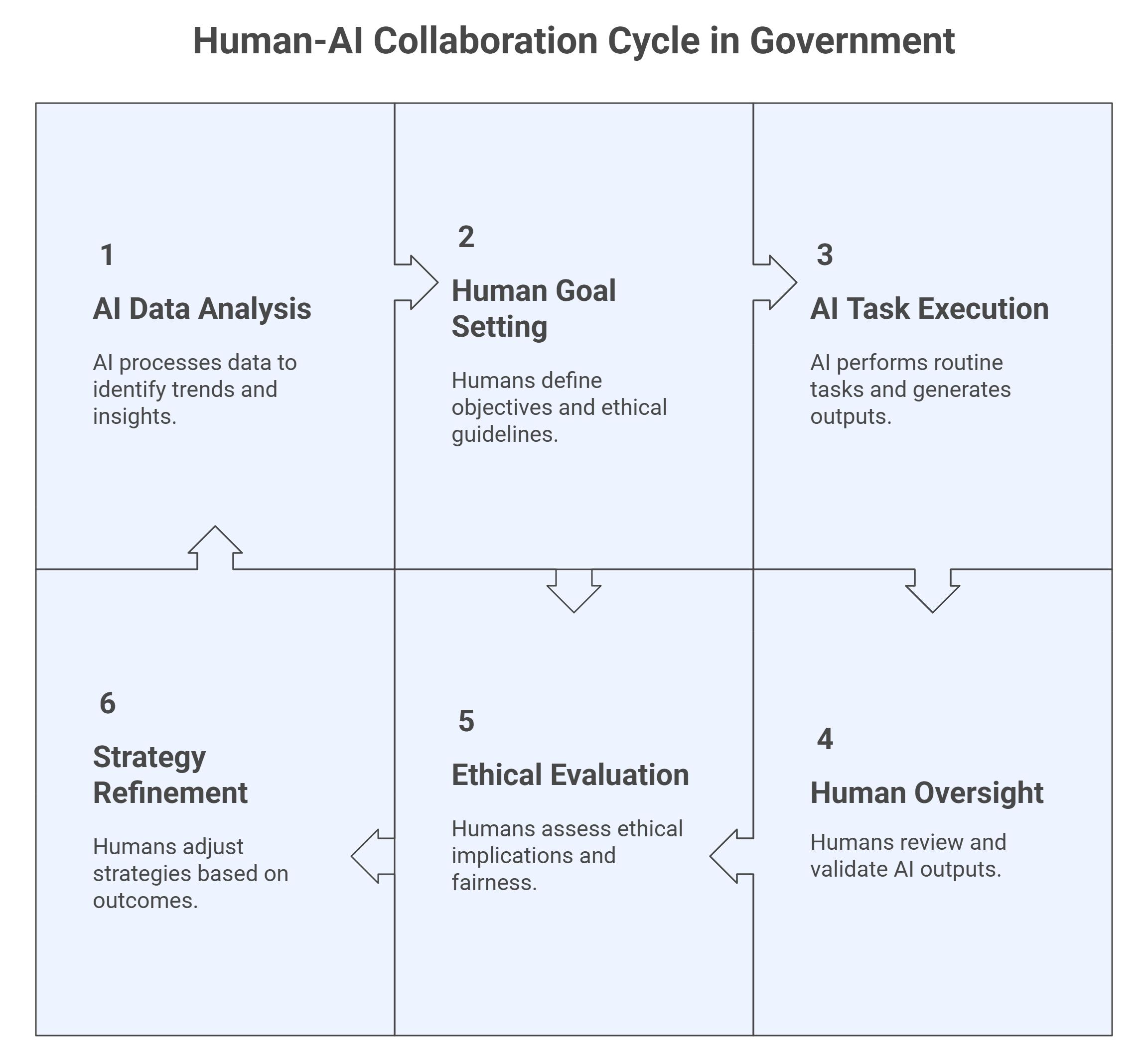

Governments worldwide are modernizing quickly to meet soaring citizen expectations for fast, personalized service. Today’s AI in government apps is enabling everything from 24/7 virtual assistants to data driven decision-making. Imagine a world where a resident’s parking permit is auto approved overnight, or a smartphone chatbot answers complex questions at midnight. These are no longer science fiction but concrete trends in digital government transformation. Emerging tech like AI, machine learning and predictive analytics are reshaping public services to be more efficient, transparent and citizen centric. For example, a recent industry analysis highlights that modern government apps use automation and AI-driven services to slash costs and response times, improve transparency, and boost citizen satisfaction.
Governments are partnering with expert providers of government application development services to build these new platforms. Leading agencies now invest in mobile citizen portals, AI chatbots, and integrated data platforms that let people apply for permits, pay fees or get help anytime, anywhere. In fact, Phoenix, Arizona’s bilingual “myPHX311” portal uses an AI chatbot built on AWS Lex to answer common citizen questions in English and Spanish around the clock. By embedding Content Management solutions into these portals, agencies can update information and services on the fly, while citizens enjoy a user-friendly experience. In short, digital government trends now prioritize citizen satisfaction and speed: 24/7 access, seamless mobile apps, and AI assistance are rapidly becoming standard.
AI chatbots for customer service are a game-changer for government apps. Unlike traditional FAQ pages, modern chatbots use natural language understanding to handle real conversations. They’re available 24/7 and instantly triage routine requests, freeing up human agents. For example, Phoenix’s “myPHX311” virtual assistant resolved most inquiries on first contact, even processing service requests like turning utilities on/off all without a human answerer. Another city, Williamsburg, Virginia, deployed an AI chatbot that answered 79% of resident questions on first contact, dramatically reducing call-center volume. These successes show that ai chatbots for customer service aren’t gimmicks they deliver real efficiency and citizen satisfaction.
Beyond chatbots, many government apps now use predictive services powered by AI analytics. By mining large public datasets (traffic flows, census data, utility usage, etc.), machine learning models can forecast what citizens will need before they even ask. For example, one App Maisters report notes AI-driven analytics are being used to flag roads that may soon need repairs or to predict budget shortfalls. Another city might use AI to forecast emergency service demand (e.g. ambulance calls) based on weather and event data, enabling pre-deployment of resources.

These predictive capabilities turn government services from reactive to proactive. An OECD study found that about 67% of advanced economies already deploy AI to tailor content and service pathways for citizens, improving responsiveness and personalization. In practice, this means:
In essence, predictive AI in apps turns data into foresight. Governments can pick up on trends that are not detectable by humans improving the responsiveness and personalization of public services. These analytics boost efficiency and citizen trust: people see that government “thinks ahead” on their behalf.
The next frontier in government apps is agentic AI, where software behaves like an autonomous digital civil servant. Unlike scripted chatbots, agentic systems make decisions and perform tasks on their own, learning from data continuously. Imagine telling an app you need a building permit: an agentic AI could automatically fill your details, check them against zoning databases, request missing documents, and even schedule an inspection all without further input. That’s far beyond a simple Q&A bot.
Key features of agentic AI for public services include:
By moving beyond basic chatbots to goal-driven agents, governments can deliver services faster and more responsively than ever. The era of clock-bound service windows is ending a citizen can initiate a request online at 2 AM and watch the digital system work on it immediately. This shift represents a game-changer for public services, one that forward-thinking agencies are already exploring.
Even as AI grows more powerful, humans remain at the wheel. Experts emphasize that AI must be a co-pilot, not a replacement for human judgment. Government leaders are building systems with human oversight in mind. For example, agencies often insert review steps: an AI might draft a permit approval, but a human inspector signs off before final issuance. This “trust but verify” model ensures accountability. As one analysis notes, AI excels at crunching data, but only humans can set goals, evaluate risk, and inject ethics into the process.
The Human Role in AI Development is crucial across government apps. Humans define the objectives public safety, equity, write ethical guidelines, and interpret ambiguous situations. In healthcare or public safety, human empathy and contextual understanding remain irreplaceable. For example, in a medical app, AI might flag high-risk patients, but a doctor must review the alert and communicate with the patient. In tax or benefits apps, humans oversee privacy and fairness rules codifying regulations that AI systems must follow. Research confirms that when humans lead strategy and trust-building, AI initiatives in government yield better outcomes.
This balanced approach is now best practice. Agencies increasingly combine automated tools with robust governance. They train staff in AI oversight, establish ethics boards, and deploy explainable AI models so humans can audit decisions. In cybersecurity, for instance, AI may detect an anomaly, but analysts review and contextualize the threat. In public services, AI chatbots answer FAQs, but actual policy changes and citizen outreach remain human-driven tasks. This partnership where AI handles data and routine tasks and humans steer strategy – creates a Human AI collaboration that maximizes both efficiency and trust.

Government apps today are built on partnerships: advanced AI tools working hand-in-hand with human experts. Agencies use machine learning to analyze community needs and detect trends, but they rely on staff to interpret, decide, and care for constituents. The image above illustrates how AI (left) boosts speed and scale, while humans right provide oversight and empathy. By combining forces, governments can speed up routine tasks like data entry or form processing and let officials concentrate on innovation and citizen interaction. Indeed, when deployed thoughtfully, AI in government amplifies human impact rather than replacing it.
These advances translate into tangible benefits:
One comprehensive review found that improved service delivery and effectiveness can boost citizens satisfaction and their trust in government when AI and data are used wisely. In practice, agencies deploying these technologies report faster response times, fewer errors, and happier staff. As App Maisters observes, digital workflows online forms, chatbots, predictive alerts make government operate more smoothly and keep constituents satisfied.
The illustration above depicts a future-ready city powered by AI agents, the glowing bridge, and integrated data icons. In such smart communities, predictive traffic control or AI-managed utilities become a reality. Citizens benefit from personalized government digital services, while government teams use AI tools to streamline operations and focus on strategic goals.
Real-world examples showcase these trends in action:
These cases illustrate a common theme: AI-driven tools freeing humans to do what they do best. In Williamsburg, after implementing a chatbot, staff were free to concentrate on complex community planning, not simple inquiries. In banking the public sector, savings from AI in one project even funded new community programs. Across the board, government technology projects that embrace these trends work faster, save money, and improve service, according to experts.
Adopting AI and chatbots in government apps requires a strategy:
Throughout, remember the Human Role in AI Development staff should maintain a critical oversight role. By combining strong human leadership with agentic AI systems, governments can achieve reliable, intelligent services.
The era of siloed offices and paper forms is ending. Emerging tech in government apps from AI chatbots to predictive analytics is empowering governments to serve citizens smarter, faster, and around-the-clock. These innovations boost efficiency, cut costs, and most importantly, meet the public’s demand for modern digital services. Leaders in digital government should act now: pilot an AI chatbot on your website, roll out predictive analytics for key services, and explore the potential of agentic AI agents.
Partnering with experts can accelerate this transformation. App Maisters, for example, has a decades-long track record in building citizen-centric government apps. Our government application development services cover everything from mobile portals to secure cloud backends. We help integrate advanced features like 508-compliant interfaces, multi-language chatbots, and enterprise content management systems into public sector solutions.
By embracing these cutting-edge trends and working with experienced partners, government agencies can unlock new levels of efficiency and engagement. The future of public service is digital, proactive, and AI-powered. Start planning your AI-driven app strategy today, and put citizens’ needs at the forefront of a smarter government.
Explore more: Check out our resources on digital government trends and Content Management solutions to learn how to modernize your services. Or read about Agentic AI for public services and the Human Role in AI Development for deeper insights. Together, we can build the next generation of government service apps.
AI in the public sector improves efficiency, transparency, and service delivery. It helps agencies analyze data, predict citizen needs, and make faster, smarter policy decisions.
Predictive analytics forecast trends like traffic, healthcare demand, or maintenance needs. Governments use it to plan resources efficiently and deliver proactive citizen services.
Agentic AI enables autonomous systems that handle full workflows like processing permits or scheduling inspections. App Maisters helps agencies integrate agentic AI for public services into digital platforms for faster, smarter operations.
AI chatbots improve communication and accessibility. They provide instant multilingual responses, reduce call center loads, and boost citizen engagement all key trends in digital government transformation.
Humans guide AI design, ensure ethical use, and oversee decision-making. App Maisters emphasizes the Human Role in AI Development, ensuring that automation supports not replaces public employees.
App Maisters builds secure, compliant AI-powered apps for governments. Our Content Management solutions and analytics tools help agencies modernize digital services and meet evolving citizen needs.
Yes. App Maisters delivers AI in government apps following strict security and compliance standards, including ISO and HIPAA certifications. Our solutions meet public sector regulations and accessibility guidelines.
Commodo elementum, sed imperdiet nunc euismod etiam aliquet viverra

App Maisters Inc is a Federal Government SBA 8(a) Certified and Texas Hub Certified company. We are a leading developer of high-performance mobile apps, websites, and enterprise solutions, that are specially designed to meet Federal, State, Local government agencies and higher education needs.
